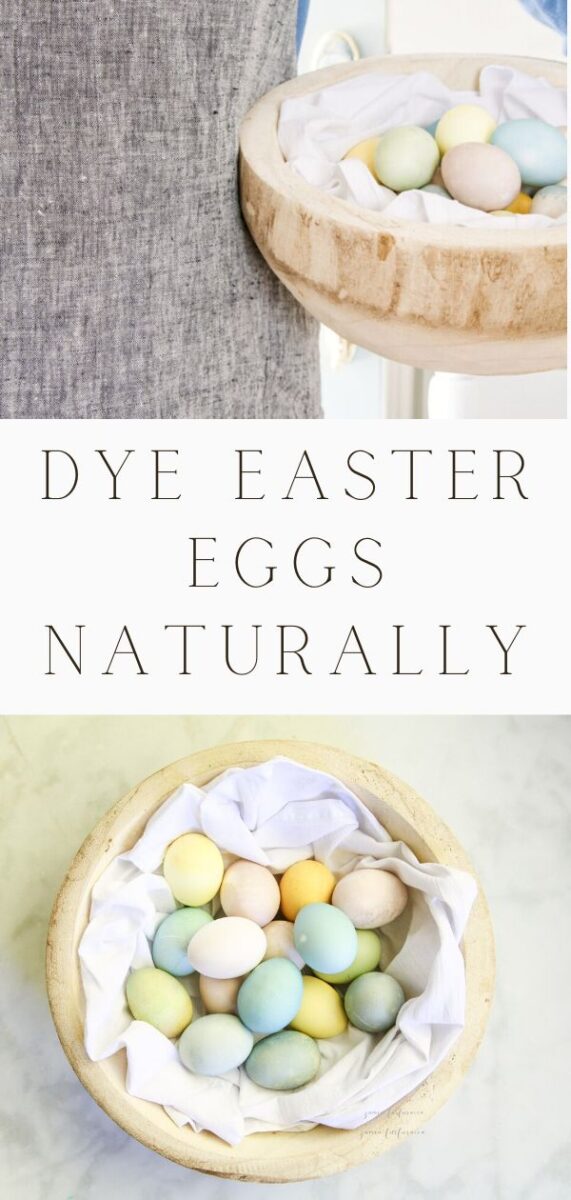Today let's talk about how to dye Easter eggs naturally using vegetables, fruit, and spices. This is a chemical-free, homemade way to dye your hard-boiled eggs using natural ingredients like cabbage and blueberries to name a few.
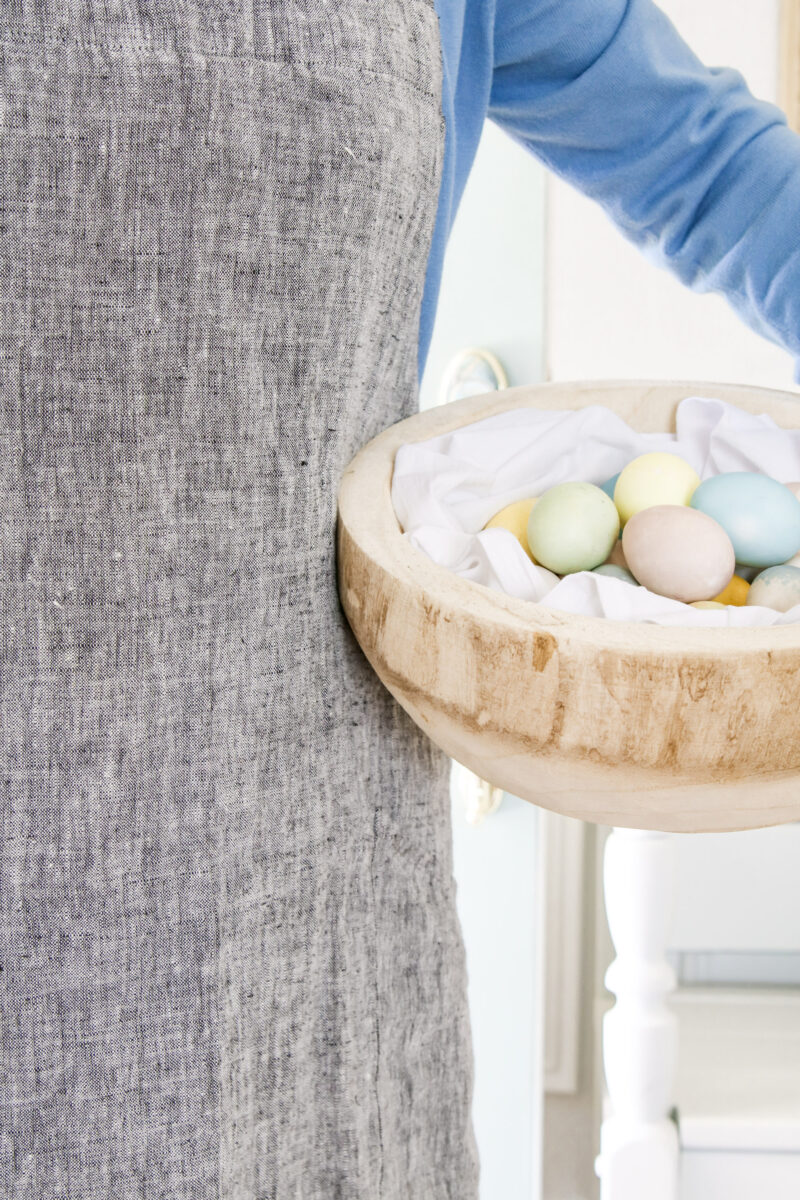
If you have been around me very long you know I love anything homemade. For years I have wanted to try my hand at dying eggs from natural ingredients like fruit and vegetables rather than using chemical dyes. So this year was the year I decided to teach myself how to dye Easter eggs naturally.
After a week of testing out different foods to make different natural dye colors, making three trips to the store, and spending a week in the kitchen, I finally found the best way to dye eggs naturally with everyday ingredients and am so happy with my beautiful easter eggs in all different colors.
I am going to be honest here — there are many many websites that have recipes on how to dye eggs the natural way and I am not sure where they got their information. I tried to follow many but in some instances, the eggs shells got eaten up or the color wasn't that pretty.
By the time I finished making the best naturally dyed Easter eggs, I felt like I had been a scientist in my own laboratory, aka kitchen. The methods I use can create beautiful light colors to lovely vibrant colors. So here is my best advice on how to dye Easter eggs using all-natural ingredients and what inspired me to dye Easter eggs to start with.
This post contains affiliate links, meaning I receive a commission if you purchase using the links below at no extra cost to you. All opinions are all my own.
Dye Easter Eggs Naturally
To begin allow yourself several days to dye hard-boiled eggs with food and spices. This recipe allows you to dye two eggs in each color at a time using a wide mouth Ball Mason jar that holds two cups of juice but if you plan to make many natural color Easter eggs then I would double or maybe triple this recipe.
Here is an example of a larger glass container I used with a snap-down lid. This is a great larger jar option for your natural dyes.
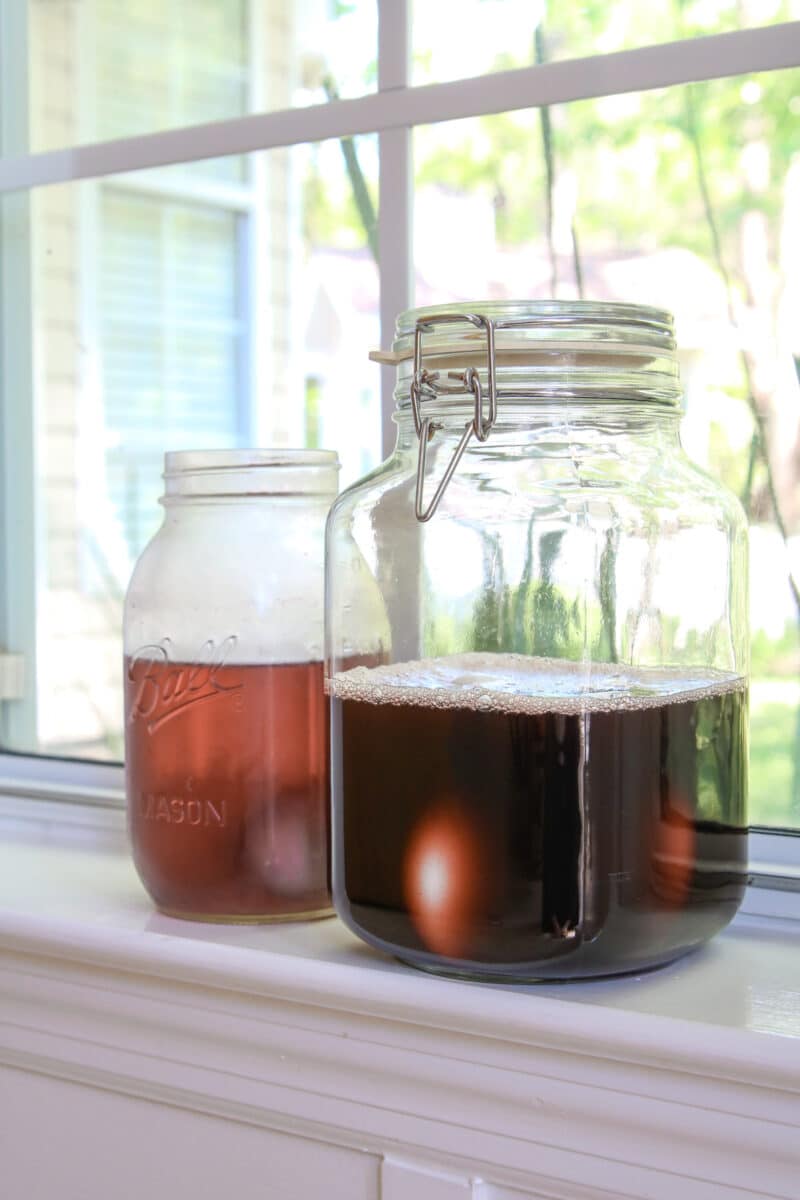
Supplies to Dye Easter Eggs Naturally
- White eggs (I found white to make the prettiest colors)
- Half Red/Purple cabbage (beautiful blue eggs)
- 1 cup Blueberries (blue eggs)
- 3 large Beets (pink eggs)
- Tumeric (yellow eggs)
- White vinegar
- Pots to boil fruit, vegetables, and spices
- Strainer
- Glass jars (I used wide mouth mason jars but if you plan to make a lot of eggs consider bigger glass jars)
- Funnel (this will provide an easy way to pour the liquid into the jars)
- Tongs
- Paper towels
Shop the post:
Best Hard Boiled Eggs to Dye Naturally
Once you have all your supplies begin making your hard-boiled eggs. I tried three different ways of boiling the eggs — the normal boiling in water, in an air-fryer, and steaming the eggs.
I found if you steam the eggs you get a more smooth look to your colored eggs. If you use the air-fryer you get a fun speckled look and normal boiling in water the color isn't as even. Now that I have the art of dying eggs naturally I will be steaming my eggs in the future.
Also, I did try dying brown eggs naturally and if you love darker colors then you may love this method. I will show a few as we go through this recipe. But for the best color results of your natural egg dyes use white eggs.
Natural Red Dye for Easter Eggs
For some reason, this one gave me the most trouble, and a funny story. I tried many different methods but the funniest was dying eggs in pickled beet juice.
I placed the eggs in the strained liquid and checked back after 5 minutes, 10 minutes, 30 minutes, and so on. Each time I pulled it out and found the most beautiful pink color but when I rinsed it the color washed off and it was almost white.
Finally, I left it in overnight, and the next day the egg shell felt like it was brittle. After letting it dry the egg shriveled up so I give pickled beet juice a thumbs down. LOL!
Now using the pickled beet juice still made pretty pale pink eggs but if you want a deeper color then try this beets dye recipe.
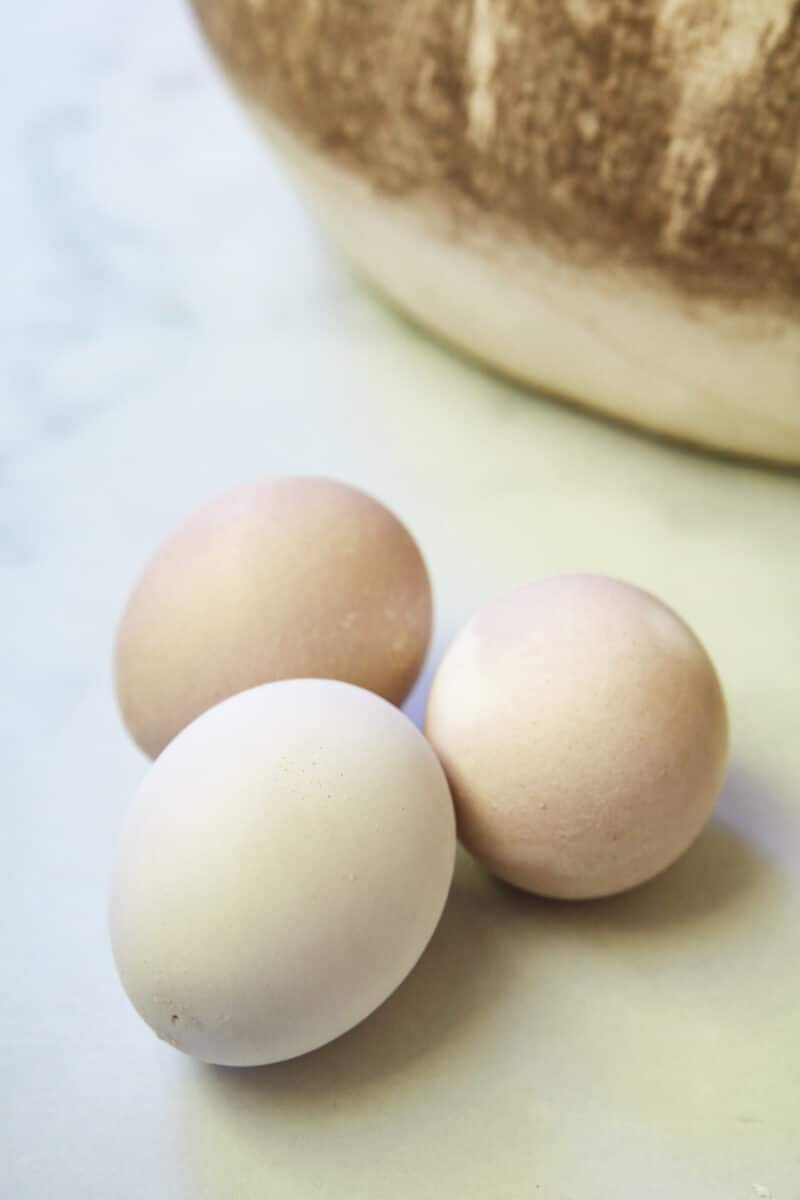
Pink Naturally Dyed Eggs Recipe – Beets
- 3 large beets
- 4 tsp white vinegar (keep in mind you want 2 tsp of vinegar per cup of juice)
- 3 cups water
Cut your beets into small pieces. I removed the peeling on the outside.
Place 3 cups of water in a pot to boil and add the cut beets. Let it boil for 15 to 20 minutes.
Remove the beets from the water and strain the beet juice into a glass jar. I used wide-mouth mason jars which hold 2 cups of juice. Fill about 3/4 full so that when you drop the egg into the jar the liquid doesn't run over the edges.
Next, let it cool for 15 to 20 minutes.
Once the juice has cooled add vinegar. I added 4 teaspoons of vinegar to my roughly two cups of juice.
Now stir the mixture with a metal spoon. Do not use wood or it will dye the wood. Now add your eggs.
To get beautifully dyed pink rose-colored eggs leave them in the dye bath for 2.5 hours. Here is another tip. The color came out stronger when I left the beet dye in the fridge overnight and then added boiled eggs to the dye the next day.
Look at the beautiful various shades achieved just by varying the soaking time. Something about letting the dye sit up for a while made it more concentrated.
Natural Yellow Dye for Easter Eggs
This was by far the easiest color to dye and the quickest. It takes overall the least amount of time to dye a yellow egg naturally.
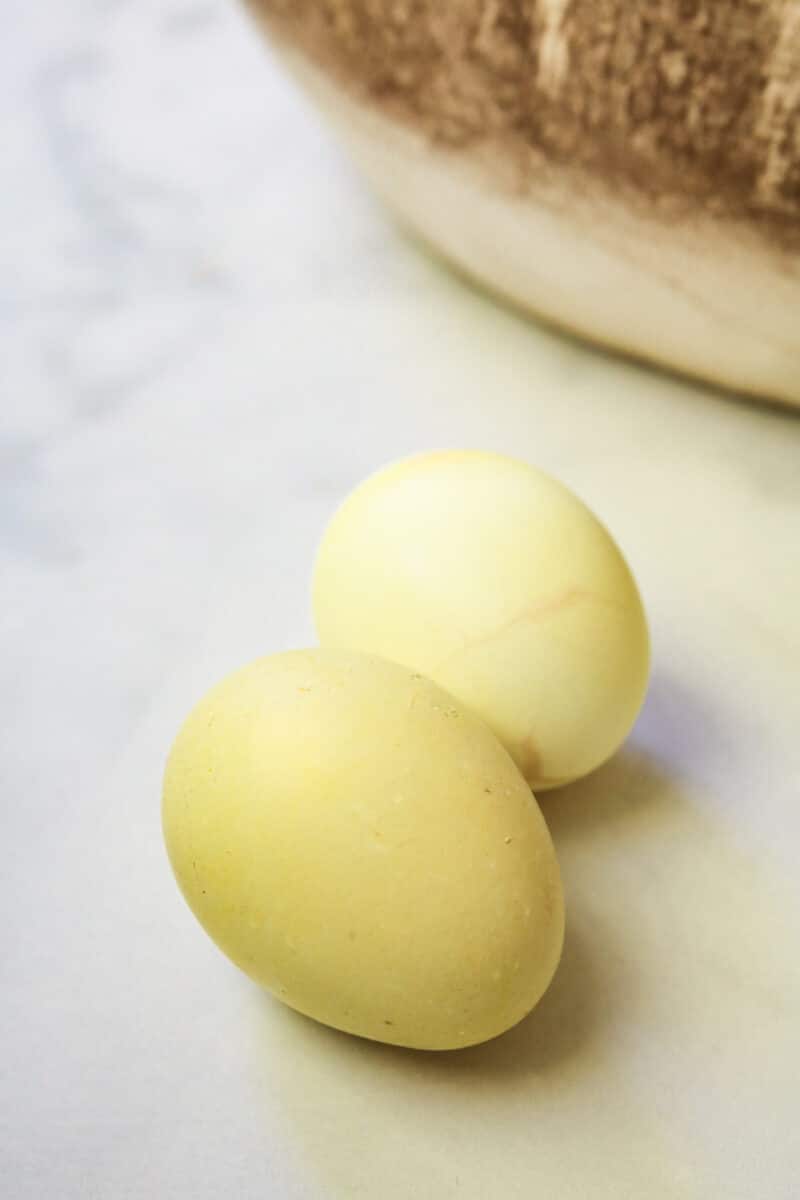
Yellow Naturally Dyed Eggs Recipe – Turmeric
- Turmeric
- 4 tsp white vinegar (keep in mind you want 2 tsp of vinegar per cup of juice)
- 3 cups water
Place 3 cups of water in a pot to boil and add the turmeric. Let it boil for 15 to 20 minutes.
Strain the turmeric juice into a glass jar about 3/4 full. I used wide mouth mason jars which hold approximately 2 cups of juice. Then let it cool for 15 to 20 minutes.
Once the juice has cooled add vinegar. I added 4 teaspoons of vinegar to my two cups of juice. Now stir the mixture with a metal spoon. Now add your eggs.
For a pale yellow egg leave it in the dye for 5 minutes. Set your timer for 5 minutes each time to get the depth of color you want.
Natural Blue Dye for Easter Eggs
Another easy natural dye to make. Blueberries are quick to dye and make such a beautiful color. This takes longer than the turmeric but much less time than beets and cabbage.
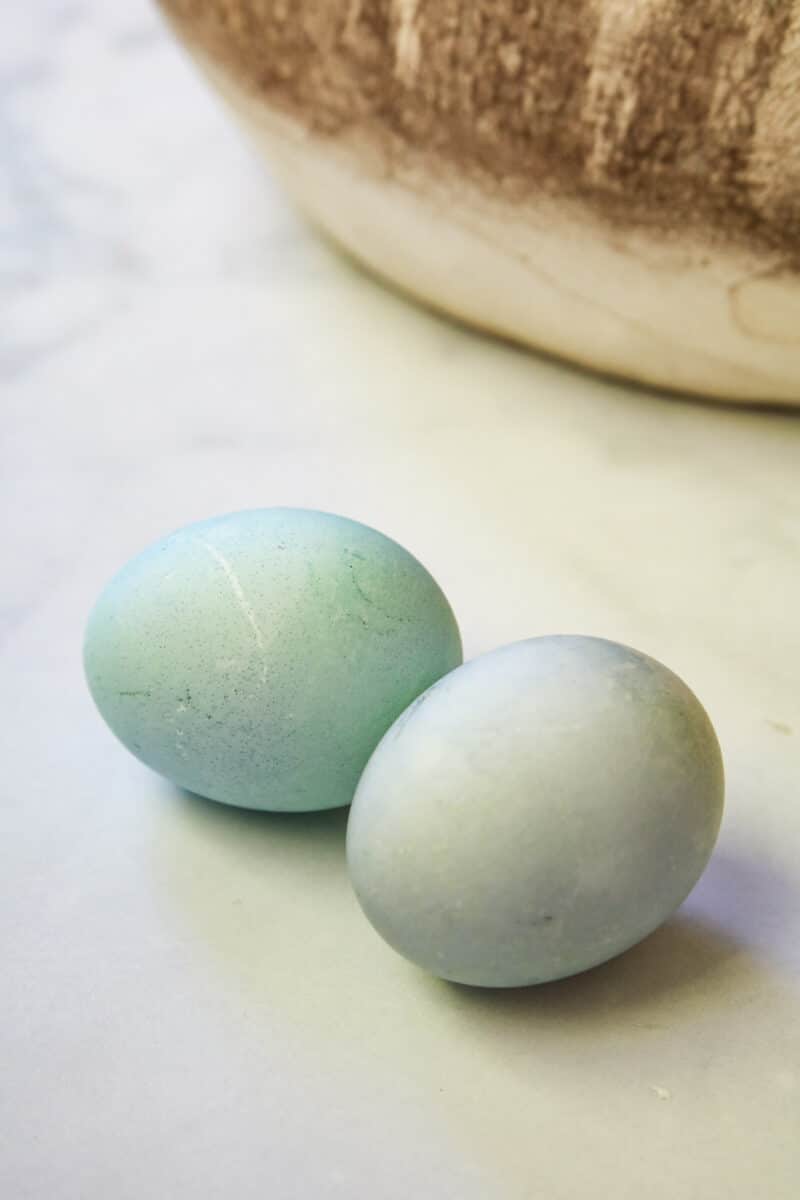
Blue Naturally Dyed Eggs Recipe – Blueberries
- 1 cup blueberries
- 4 tsp white vinegar (keep in mind you want 2 tsp of vinegar per cup of juice)
- 3 cups of water
Place 3 cups of water in a pot to boil and add the blueberries. Let it boil for 15 to 20 minutes.
Remove the blueberries and then strain the blueberry juice into a glass jar. Then let it cool for 15 to 20 minutes.
Once the juice has cooled add vinegar. I added 4 teaspoons of vinegar to my two cups of juice. Now stir with a metal spoon. Now add your eggs.
For a light blue color leave it in the dye for 15 minutes. Set your timer for 5 minutes increments after that until you get the shade of blue you want.
Natural Blue-Green Dye for Easter Eggs
Here is another easy natural dye to make and I was surprised that red/purple cabbage makes a blue-green color. This takes hours to soak and comes out so pretty.
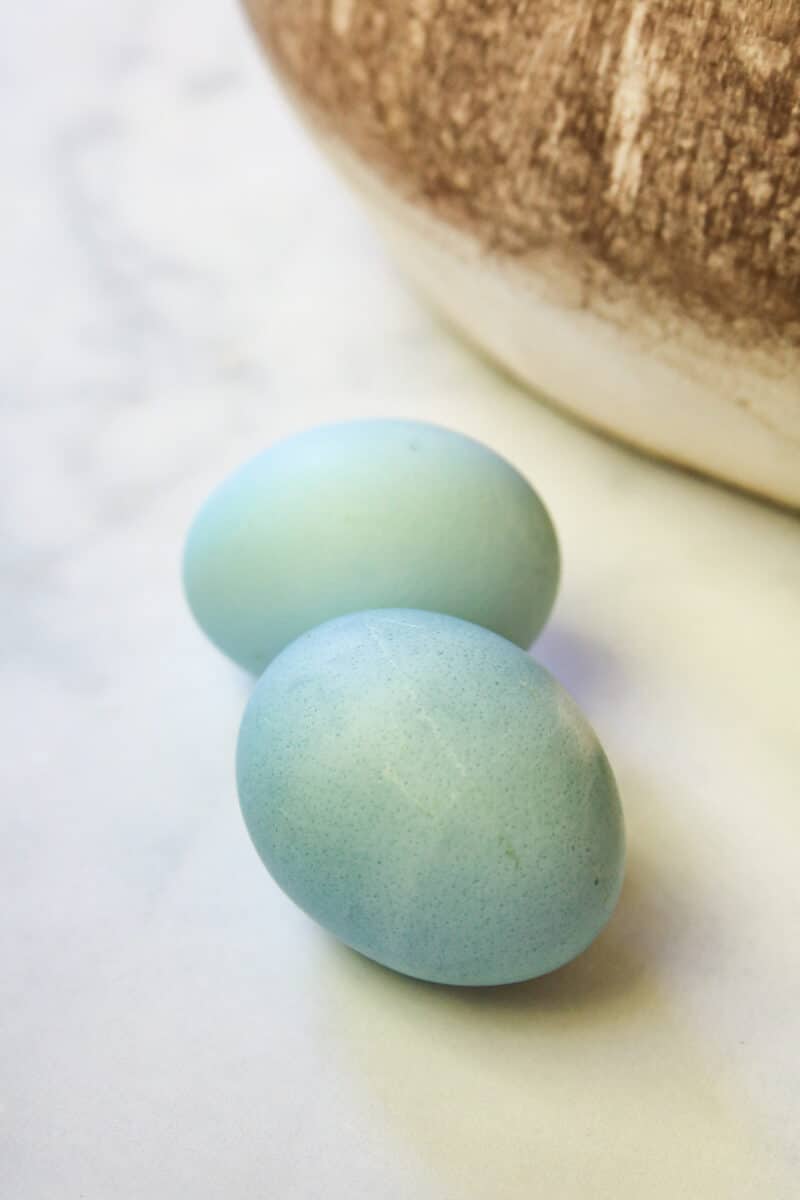
Blue-Green Naturally Dyed Eggs Recipe – Red/Purple Cabbage
- 1/2 cabbage
- 4 tsp white vinegar (keep in mind you want 2 tsp of vinegar per cup of juice)
- 3 cups of water
Place 3 cups of water in a pot to boil and add sliced cabbage. Let it boil for 15 to 20 minutes.
Remove the cabbage and then strain the cabbage juice into a glass jar. Then let it cool for 15 to 20 minutes.
Once the juice has cooled add vinegar. I added 4 teaspoons of vinegar to my two cups of juice. Now stir with a metal spoon. Now add your eggs.
For a bright blue color set your timer for 4.5 hours.
Natural Green Dye for Easter Eggs
After I finished dying the other colors I used the blueberry and turmeric dyes to make green color. This was very simple to do and within an hour I had beautiful green Easter eggs.

Green Naturally Dyed Eggs Recipe – Blueberry and Turmeric
- 3/4 cup blueberry dye
- 3/4 cup turmeric dye
Add the blueberry and turmeric dye to a mason jar and then stir together. Next, add your eggs.
For a beautiful light green egg set your timer for 45 minutes. If you want darker green keep them in the dye and check on them every 15 minutes until you get the ton you want.
Natural Orange Dye for Easter Eggs
For my project I stuck with my favorite colors but if you want to make naturally dyed orange Easter eggs simply follow one of my other recipes but boil the brown-colored egg peelings. From what I can tell this is another easy dye to make.
Best Tips for Dying Easter Eggs Naturally
Here are some tips to help you make your egg dying experience even more positive.
- When you add the vinegar remember that this juice will DYE ANYTHING AND EVERYTHING. Make sure to wear an apron that you don't mind it getting dyed on. And cover your work area with something like cardboard or a cutting board that you don't mind getting dyed. Also, if children will be helping dye eggs keep paper towels handy so you can wipe up the spills right away.
- Make sure to use heat-safe glass containers for your juice. Even this natural dye might leave color in your jars at the bottom.
- When leaving your eggs in the liquid set your timer so you don't forget. It makes keeping track of the time so much easier and helps ensure you achieve the desired color. Whether you prefer muted colors or vibrant colors, you're sure to achieve it with the options provided.
- Make your dye baths one day and then dye the eggs another day. The dye will work much better the second day after it has had time to sit. It also makes the process more enjoyable because it won't take up as much of your day.
- Every egg is going to come out looking different. The variety of different shades is the beauty of dying Easter eggs with natural ingredients. You will notice in my stack that some are smooth looking and some are speckled. If you want a smoother look steam your eggs, for a speckled dyed egg put them in an air fryer.
- And when you are finished put lids on the jars and you can use the natural dye for other projects later like dying fabric. This is why I used the wide mouth Ball Mason jars with lids and larger jars with snap-down lids so that I could store them in my fridge for later.
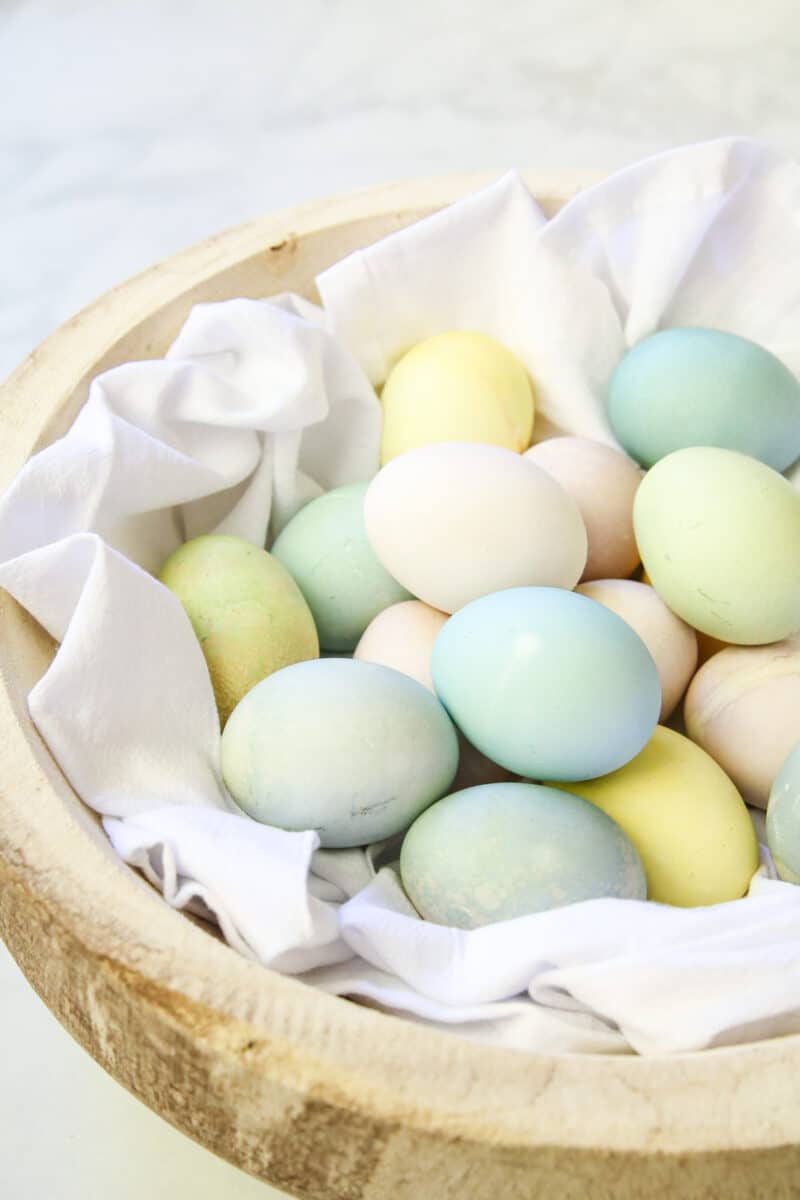
Now, remember me mentioning what inspired me to do this project? Well, there are three reasons.
Why Did We Dye our Easter Eggs With Natural Ingredients
First, we have been trying to live more naturally with our foods for a while so I wanted to dye eggs using farm-to-table ingredients rather than artificial dyes.
Second I wanted to have a pretty naturally dyed egg option to decorate a tablescape and give you an idea for your Easter Sunday lunch.
And last, I had some adorable visitors come over which is what inspired me to dye these eggs to start with.
Paradise Found Farms – Poultry Farm
Meet Snow and the baby chicks from Paradise Found Farms.
Aren't they adorable!
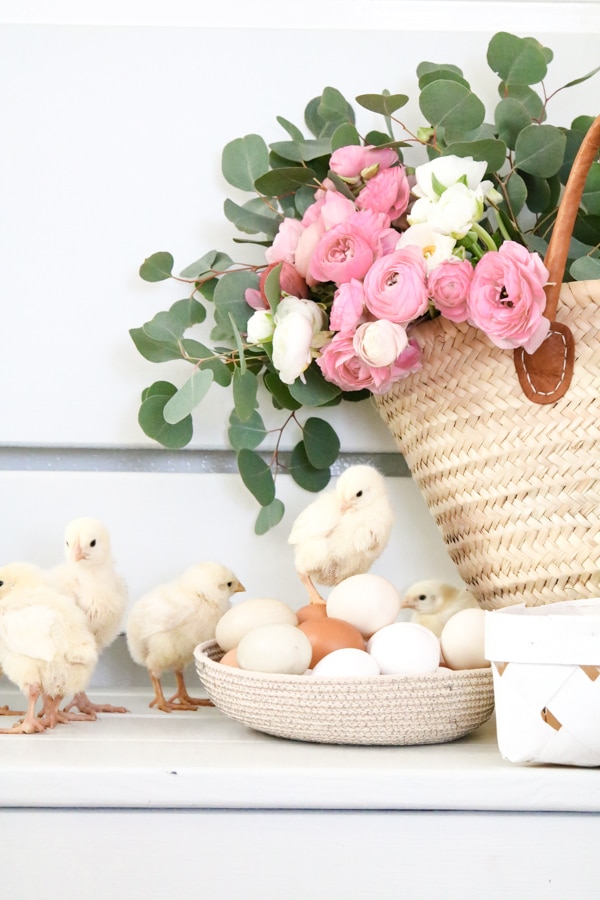
With spring here and Easter coming fast I thought some photos of baby chicks would brighten your day but when Kris at Paradise Found Farms suggested she bring a chicken I would have never guessed that I would become so fond of a chicken.
I mean really! Look how beautifully she posed for the camera. LOL!

We had a blast taking pictures of Kris and Kellys' chicks. When we first started talking about bringing them to my home, so I could photograph them, I thought wouldn't it be fun to dye some eggs to go along with the photos. And that is where it all started with this post.
My wheels started turning as I thought about an idea for your Easter table with beautiful natural dyed Easter eggs.
Consider using these naturally dyed eggs as a place setting decoration for Easter. It's a great way to bring a touch of color to your tablescape. You can easily place a small handmade clay bowl on each salad plate and then place grass and these eggs on top.
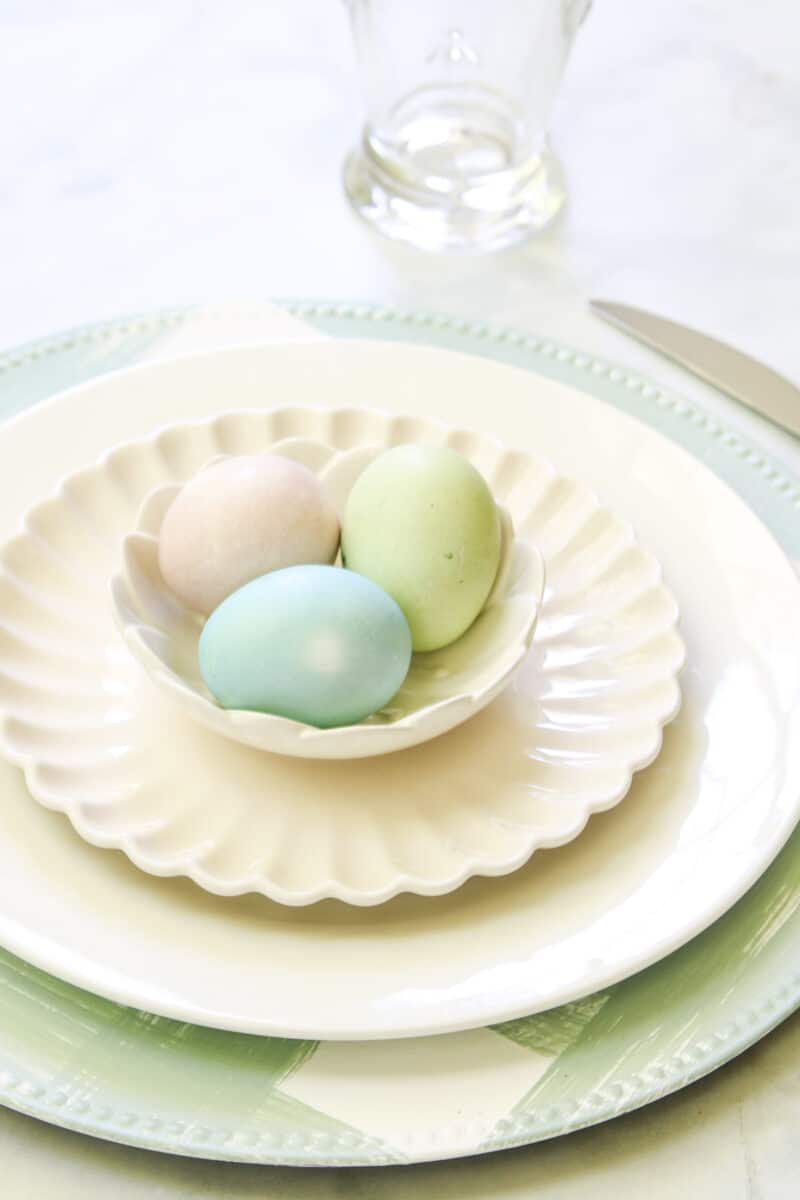
And I have many spring tablescapes you can try like this dollar store spring tablescape and this garden party table.
And keep an eye out on my YouTube because I will be sharing about the day Snow the chicken and her chicks came to visit.
I hope you have been inspired to dye Easter eggs naturally. It is much better for you and your family plus they make such pretty colored eggs.
Comment if you prefer naturally dyed eggs or a store-bought kit and good luck on your Easter egg dye adventure. Feel free to ask me any questions if you plan to dye eggs naturally. I would love to hear how your own natural Easter egg dyes turned out. Have a wonderful Easter!
Happy Decorating!

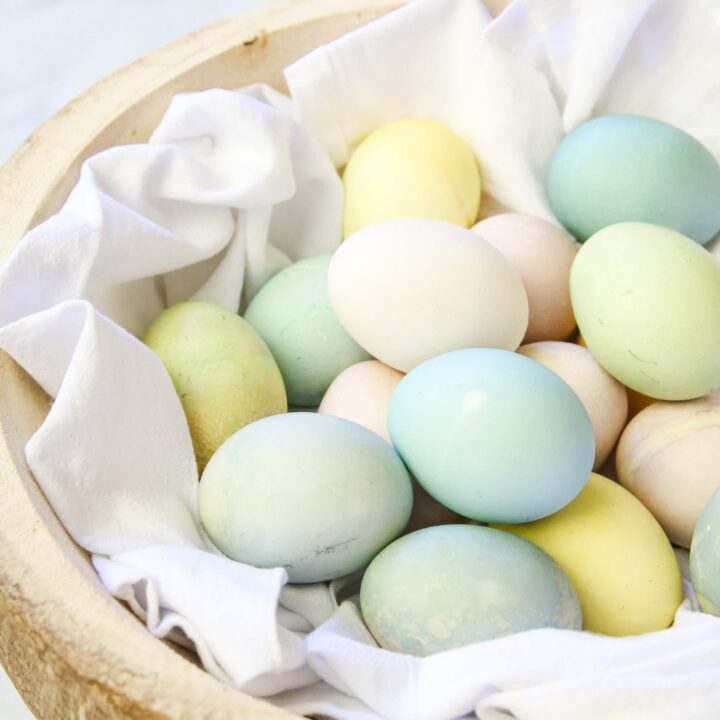
How to Dye Easter Eggs Naturally
After spending a week in our kitchen testing different ways to dye Easter eggs naturally here is our best advice and easy steps.
Materials
- White eggs (I found white to make the prettiest colors)
- Half Red/Purple cabbage (beautiful blue-green eggs)
- 1 cup Blueberries (blue eggs)
- 3 large Beets (pink eggs)
- Tumeric (yellow eggs)
- White vinegar
Tools
Instructions
Natural Pink Dye for Easter Eggs
- Cut beets into small pieces
- Place 3 cups of water in a pot to boil and add the cut beets. Let it boil for 15 to 20 minutes.
- Remove the beets from the water and strain the beet juice into a glass jar. I used wide-mouth mason jars which hold 2 cups of juice.
- Let it cool for 15 to 20 minutes.
- Once the juice has cooled add vinegar. I added 4 teaspoons of vinegar to my two cups of juice.
- Now stir the mixture with a metal spoon. Do not use wood or it will dye the wood.
- Add your eggs.
- To get beautifully dyed pink rose-colored eggs leave them in the dye bath for 2.5 hours.
Natural Yellow Dye for Easter Eggs
- Place 3 cups of water in a pot to boil and add the turmeric. Let it boil for 15 to 20 minutes.
- Strain the turmeric juice into a glass jar. I used wide mouth mason jars which hold 2 cups of juice. Then let it cool for 15 to 20 minutes.
- Once the juice has cooled add vinegar. I added 4 teaspoons of vinegar to my two cups of juice. Now stir the mixture with a metal spoon.
- Add your eggs.
- For a pale yellow egg leave it in the dye for 5 minutes. Set your timer for 5 minutes each time to get the depth of color you want.
Natural Blue Dye for Easter Eggs
- Place 3 cups of water in a pot to boil and add the blueberries. Let it boil for 15 to 20 minutes.
- Remove the blueberries and then strain the blueberry juice into a glass jar. Then let it cool for 15 to 20 minutes.
- Once the juice has cooled add vinegar. I added 4 teaspoons of vinegar to my two cups of juice. Now stir with a metal spoon.
- Add your eggs.
- For a light blue color leave it in the dye for 15 minutes. Set your timer for 5 minutes increments after that until you get the shade of blue you want.
Natural Blue-Green Dye for Easter Eggs
- Place 3 cups of water in a pot to boil and add sliced cabbage. Let it boil for 15 to 20 minutes.
- Remove the cabbage and then strain the cabbage juice into a glass jar. Then let it cool for 15 to 20 minutes.
- Once the juice has cooled add vinegar. I added 4 teaspoons of vinegar to my two cups of juice. Now stir with a metal spoon.
- Add your eggs.
- For a bright blue color set your timer for 4.5 hours.
Natural Green Dye for Easter Eggs
- Add the blueberry and turmeric dye to a mason jar and then stir together. Next, add your eggs.l
- For a beautiful light green egg set your timer for 45 minutes. If you want darker green keep them in the dye and check on them every 15 minutes until you get the ton you want.
Natural Orange Dye for Easter Eggs
- If you want to make naturally dyed orange Easter eggs simply follow one of my other recipes but boil the brown-colored egg peelings.
Notes
- When you add the vinegar remember that this juice will DYE ANYTHING AND EVERYTHING. Make sure to wear an apron that you don't mind it getting dyed on. And cover your work area with something like cardboard or a cutting board that you don't mind getting dyed. Also, if children will be helping dye eggs keep paper towels handy so you can wipe up the spills right away.
- Make sure to use heat-safe glass containers for your juice. Even this natural dye might leave color in your jars at the bottom.
- When leaving your eggs in the liquid set your timer so you don't forget. It makes keeping track of the time so much easier and help ensure you achieve the desired color. Whether you prefer muted colors or vibrant colors, you're sure to achieve it with the options provided.
- Make your dye baths one day and then dye the eggs another day. The dye will work much better the second day after it has had time to sit. It also makes the process more enjoyable because it won't take up as much of your day.
- Every egg is going to come out looking different. The variety of different shades is the beauty of dying Easter eggs with natural ingredients. You will notice in my stack that some are smooth looking and some are speckled. If you want a smoother look steam your eggs for a speckled dyed egg put them in an air fryer.
- And when you are finished put lids on the jars and you can use the natural dye for other projects later like dying fabric. This is why I used the wide mouth Ball Mason jars so that I could put lids on them and store them in my fridge for later.
